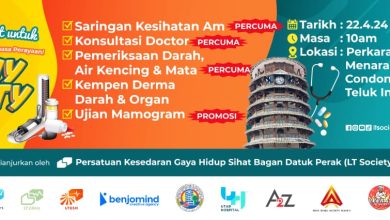Eye Health
Ipoh Echo’s EYE HEALTH series continues with Consultant Eye Surgeon Dr S.S. GILL talking to us about how to minimise eye stress.
You feel like your eyes are going to pop out of their sockets after a hard day’s work! Well, you are not alone especially when our world today is filled with bright lights from screens in computers, laptops, smart phones and even from the monitors right in front of you when you travel on an airplane! Here are some practical pointers to help reduce their effects:


The first thing that you need to do is to adjust the brightness of your monitor to an optimum level. While the software on your PC will be able to auto-adjust the brightness of your screen, this is optimum only for the running of your computer but not necessarily optimum for your eyes. For this, you would need to manually adjust it so that the screen is just right for you. One tip is to keep the screen only as bright as you need it to be, and not any brighter. You will find this helpful when you have to work long hours in front of the screen.
2. SITTING TOO CLOSE TO THE SCREEN
Avoid sitting too close to the screen as this causes eye fatigue or tiredness. Small screens usually force people to sit closer to the screen when working. So, if you are working with a small screen for hours on end, you may want to invest in a decent sized screen. You should be comfortably seated approximately 50-70cm away from your monitor.
3. PROPER REFRACTIONS
Proper prescription glasses are very important. Wearing an old pair of spectacles with outdated powers can add to eye strain. Make sure that you check on the powers annually so that you are wearing the right spectacle powers. It would be wise for those of you who spend hours in front of your computers, to indicate to your optometrist the distance in which you are usually seated away from the screen when you work so that the powers can be adjusted accordingly.
4. KEEPING THE ROOM BRIGHTNESS OPTIMAL
Room lighting is more than just creating a good ambiance and this is often an overlooked fact. Maintaining your room lighting at an optimum brightness is an important aspect of reducing eye strain. The room lighting in which you work should not be so much brighter than your computer screen.
5. SEATING POSITION
If you have to sit in front of your monitor with your face near the screen, your chin jutting forward and your back hunched up, then you can be almost certain that you will suffer from eye strain. If you have to do this to be able to work effectively, then you will need to look into why this is happening. Apart from the reasons mentioned above, having a proper chair which encourages good posture is recommended.
6. CHANGING THE FONT SIZE
Most people think that increasing the text size is only for those with poor vision but in fact larger text size is less taxing on the eyes and helps reduce eye strain. So, for “eye-sake”, get those fonts a little larger than you require them.
7. TAKING A BREAK
Follow the 20-20-20 rule and take a break every 20 minutes, looking out 20 metres for at least 20 seconds. Ideally after 20 minutes of working, take a short walk and drink a glass of water…but make sure you don’t get into trouble with your boss!


